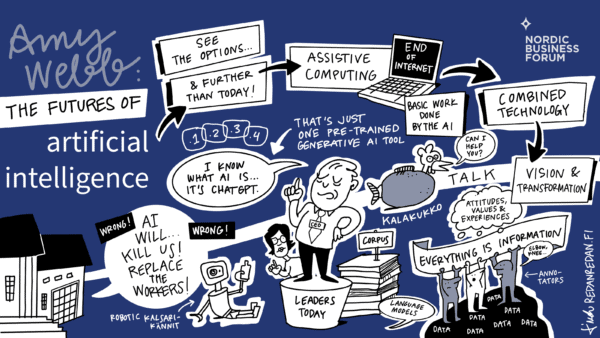10Oct2023
Everyone is talking about AI, but almost everyone gets it wrong. Futurist and author Amy Webb gave the Nordic Business Forum audience insights about where AI might really be heading.
As a futurist, author, and AI expert, Amy Webb has spent her career trying to predict where new technology, such as AI, is going. At this year’s Nordic Business Forum, she explained why nobody—not even her—can be sure about what’s to come.
“My job title is futurist,” she said, “I cannot predict the future of AI because there are too many interdependent variables in play.”
Business, she said, routinely gets two things wrong about AI. Those who have seen too many movies think it will spell the end of mankind; others believe that it will make humans redundant. In reality, though, the future is much more complex, hard to predict, and exciting.
“As AI evolves,” Amy added, “it will require entire segments to be reimagined.”
The Road to AI
AI has been part of the human consciousness for hundreds of years. When Ada Lovelace was designing the first computer in the 1840s, she envisaged a world in which computers would start to think like humans.
The current road began in 2017 when Google Researchers published the paper “Attention is All You Need —a New Way to Handle Information Processing.” This reimagined the concept of AI using complicated setups and Large Language Models that could analyze and interpret text, and generate images, processes and business insights. The use of these models changed the game for AI. It was like having a super-efficient translator that knew exactly where to look and allowed AI to generate smart, human-sounding, and contextually relevant outputs.
While AI is nothing new, it’s only recently that it has become a regular topic of conversations and headlines in media. So what has changed? In November 2022, Open AI took a system it had already had for a while and made it available to the general public. That system was called ChatGPT, and ever since then, AI has leaped to the forefront of business and public discourse. When businesses talk about the future, most of the time, they are focusing on ChatGPT and generative AI, but in reality, that is not all there is. Amazon, Facebook, Google, and other big tech companies are also working on AI.
It’s All About the Data
When you type something into ChatGPT and get an answer, you don’t necessarily stop to think: why does this work? Where did the data come from? Who did the training? To truly understand AI, you need to know how it was created and trained. ChatGPT, for example, was created using progressively complex datasets.
GPT1 was trained on something called BookCorpus, which is a database of 7,000 books.
GPT2 was trained on the same material, plus millions of web pages, Wikipedia, and Reddit.
GPT3 was based on all the previous, plus other sources of data. The most important difference in this version is that the developers started to cloak where the information is coming from.
Moving into ChatGPT 4, the data is becoming even more complex – and even less transparent. One of the databases used for training the 4th version was a corpus called Book3, a database made up of around 187,000 published books that have been illegally scrapped – including Amy Webb’s books. Whenever you look for an answer from Chat GPT, her work is part of what’s giving you the answers.
The upshot is that AI is powered by a vast amount of data, and that can give it the power to do some amazing things in the realm of assistive computing. It is here that Amy believes the real future lies and offers up three examples, each of which can change the world for better and for worse.
Direct information: Search engines are now great at giving us direct information quickly without needing to enter a website. However, this information often comes with zero context. On the one hand, this might encourage people to engage in conversations more, but on the other hand, it’s bad news for publishers who might lose out on readers.
Gathering & organizing information: AI can go through text, extract all the relevant information and summarize it. Now AI can do this for screenshots, articles, and keynotes. This is great for organizing information quickly, but it’s an easy way for students to slack off on their studies.
Business insights: By quickly scanning financial statements, AI can quickly give insights into how businesses can improve financial performance. This is great for managers who know how to write AI prompts and delegate, but probably bad for consultants. who provide this type of service.
Psst! Want to get the full summary of the Nordic Business Forum 2023 speeches + extra content for reflecting on your learning? Download your free copy of the full Executive Summary and summaries from previous events!
AI Is Not Magic
AI doesn’t just happen on its own, it requires the seemingly invisible work of millions of humans who are training AI behind the scenes. A part of how AI is trained involves Reinforcement Learning with Human Feedback (RHLF). To explain this simply, to confirm that AI has the right answer, a human needs to double-check the AI’s answers in the training phase. It’s usually gig workers in developing economies such as Pakistan and Kenya doing this work.
“AI can be magical,” Amy told the audience, “but it is not magic.” AI works only as well as it is trained. The sophistication of the AI depends on what the trainers know, understand, and recognize. As an example, Amy used an ironic statement: “Yay, cold MacDonalds.” Can we trust that the trainers and, eventually, the AI, would understand the irony, or would they take the statement literally?
She also showed the audience pictures developed by the AI Midjourney. When Amy asked Midjourney to provide illustrations of a “CEO of a large hospital system,” it only came up with pictures of white, middle-aged men. Frustrated she couldn’t get the system to imagine a woman as a CEO, her next command to it was “CEO of a company that produces tampons.” Still, the system produced men – and some weird looking sanitary products.
Is it possible that the reason the system is incapable of producing an image of a female CEO or a realistic tampon is that the trainers have never seen one? The human biases and errors are being transferred on to AI by it’s trainers, and this is why Amy doesn’t believe AI will be replacing humans any time soon.
The Future of AI
Moving into the future, Amy suggested businesses need to think about the conversations they will have with customers, how to upskill their workforce for the age of assistive computing, and what implications this might have for education. To use AI, you need to trust it. To trust it, you need to know where the data is coming from and who is behind it. You should be asking:
- Who is doing the training?
- How is the technology being integrated?
- What if big tech is making decisions for everyone?
- Does American-built AI understand realities and nuances in other countries?
Once you start trusting AI, you get into the real opportunities for AI. As technology advances, it will create more opportunities, some of which can be hard to predict. AI can already help to undertake complex cognitive tasks more quickly than humans can. It is being integrated more seamlessly into everyday life. Technologies exist on the near horizon that can instantly record everything that happens in a day and produce real-time summaries of every meeting attended.
Interaction with AI will be happening all the time. It transforms computing. “Talking,” Amy suggested, “will be the new typing,” and that can become a problem. “Business,” she warned, “is not prepared for a world where computing becomes conversational.”
Most people in the world of business are still looking at AI with a short-term, iterative focus on how they can improve what they do today. In reality, people should be adopting a longer-term vision thinking about what AI can do further into the future and tying it back into the present.
“The future, regardless of what you’re hearing, is not predictable,” Amy concluded. “It is not determined it is up to you and the choices you are making today and the very long-term planning you are willing to do. It’s the result of you and your decisions.”

Visual summary of Amy Webb’s keynote by Linda Saukko-Rauta


